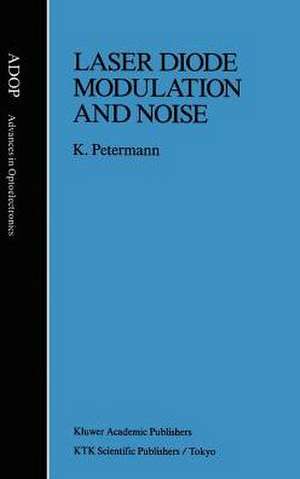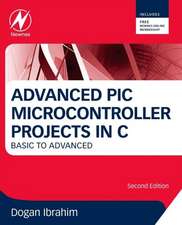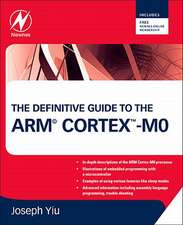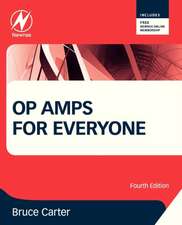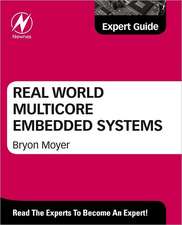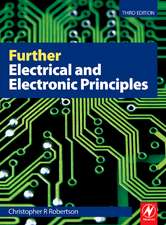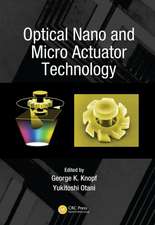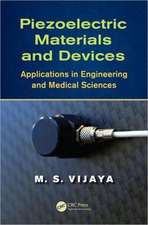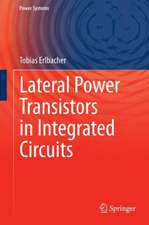Laser Diode Modulation and Noise: Advances in Opto-Electronics, cartea 3
Autor Klaus Petermannen Limba Engleză Hardback – 31 iul 1988
| Toate formatele și edițiile | Preț | Express |
|---|---|---|
| Paperback (1) | 1654.49 lei 6-8 săpt. | |
| SPRINGER NETHERLANDS – 30 apr 1991 | 1654.49 lei 6-8 săpt. | |
| Hardback (1) | 1660.50 lei 6-8 săpt. | |
| SPRINGER NETHERLANDS – 31 iul 1988 | 1660.50 lei 6-8 săpt. |
Preț: 1660.50 lei
Preț vechi: 2025.00 lei
-18% Nou
Puncte Express: 2491
Preț estimativ în valută:
317.78€ • 330.54$ • 262.34£
317.78€ • 330.54$ • 262.34£
Carte tipărită la comandă
Livrare economică 14-28 aprilie
Preluare comenzi: 021 569.72.76
Specificații
ISBN-13: 9789027726728
ISBN-10: 9027726728
Pagini: 328
Ilustrații: XII, 315 p.
Dimensiuni: 156 x 234 x 23 mm
Greutate: 0.65 kg
Ediția:1988
Editura: SPRINGER NETHERLANDS
Colecția Springer
Seria Advances in Opto-Electronics
Locul publicării:Dordrecht, Netherlands
ISBN-10: 9027726728
Pagini: 328
Ilustrații: XII, 315 p.
Dimensiuni: 156 x 234 x 23 mm
Greutate: 0.65 kg
Ediția:1988
Editura: SPRINGER NETHERLANDS
Colecția Springer
Seria Advances in Opto-Electronics
Locul publicării:Dordrecht, Netherlands
Public țintă
ResearchCuprins
1 Introduction.- 2 Basic Laser Characteristics.- 2.1 Double heterostructure characteristics.- 2.2 Direct and indirect semiconductors.- 2.3 Emission and absorption.- 2.4 Lasing characteristics of Fabry—Perot-type lasers.- 2.5 Dynamic single-mode laser structures.- References.- 3 Longitudinal Mode Spectrum of Lasing Emission.- 3.1 Multimode rate equations.- 3.2 Spectral envelope for Fabry—Perot-type lasers (linear gain).- 3.3 Influence of nonlinear gain on the spectral characteristics.- References.- 4 Intensity-Modulation Characteristics of Laser Diodes.- 4.1 Modulation characteristics by studying single-mode rate equations.- 4.2 Influence of lateral carrier diffusion on relaxation oscillation damping.- 4.3 Modulation bandwidth limits due to parasitic elements.- 4.4 Examples for high speed modulation of laser diodes.- 4.5 Modulation and longitudinal mode spectrum.- 4.6 Modulation with binary signals.- 4.7 Harmonic and intermodulation distortions (without fibre interaction).- References.- 5 Frequency-Modulation Characteristics of Laser Diodes.- 5.1 Relation between intensity-modulation and frequency modulation.- 5.2 Current/frequency-modulation characteristics.- 5.3 Chirp effects in directly modulated laser diodes.- 5.4 Possibilities of modifying the chirp parameter ?.- References.- 6 Instabilities and Bistability in Laser Diodes.- 6.1 Repetitive self-pulsations due to lateral instabilities.- 6.2 Instability and bistability in laser diodes with segmented contacts.- References.- 7 Noise Characteristics of Solitary Laser Diodes.- 7.1 Relative intensity noise (RIN).- 7.2 Introduction of the spontaneous emission noise.- 7.3 Intensity noise of laser diodes.- 7.4 Statistics of intensity noise.- 7.5 Mode partition noise for the transmission of pulse-code modulated(PCM)-signals.- 7.6 Phase and frequency noise.- References.- 8 Noise in Interferometers Including Modal Noise and Distortions.- 8.1 Noise in interferometers.- 8.2 Modal noise.- 8.3 Modal noise and distortions in single-mode fibres.- References.- 9 Semiconductor Lasers with Optical Feedback.- 9.1 Amplitude and phase conditions for laser diodes with external cavities.- 9.2 Dynamics of laser diodes with external reflections.- 9.3 Laser diodes with distant reflections.- References.- 10 Laser Diodes with Negative Electronic Feedback.- 10.1 Modulation characteristics of laser diodes with negative electronic feedback.- 10.2 Linewidth narrowing and phase noise reduction with negative electronic feedback.- References.- 11 Circuitry for Driving the Laser Diode.- 11.1 Schemes for stabilizing the bias current.- 11.2 Laser drivers with optoelectronic integration.- References.
